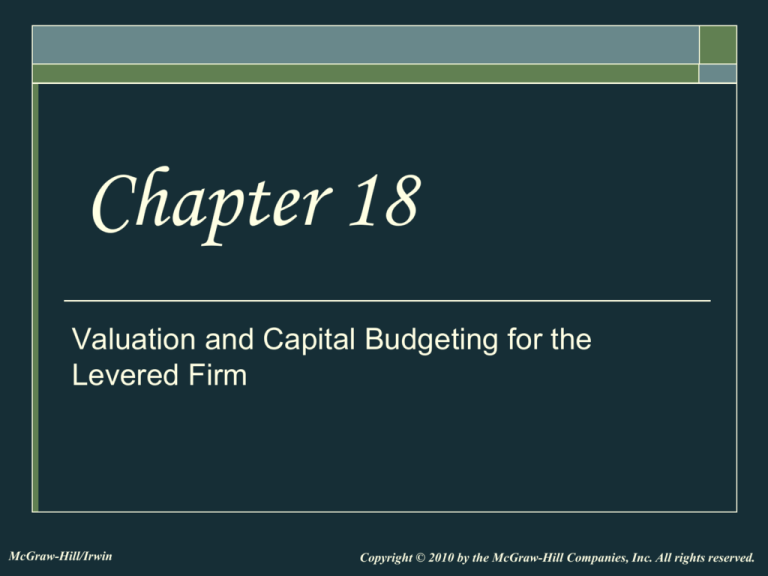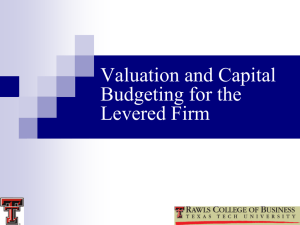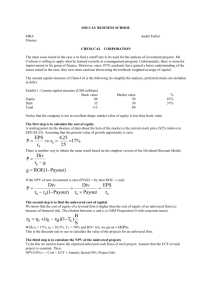
Chapter 18
Valuation and Capital Budgeting for the
Levered Firm
McGraw-Hill/Irwin
Copyright © 2010 by the McGraw-Hill Companies, Inc. All rights reserved.
Key Concepts and Skills
Understand the effects of leverage on the
value created by a project
Be able to apply Adjusted Present Value
(APV), the Flows to Equity (FTE) approach,
and the WACC method for valuing projects
with leverage
18-1
Chapter Outline
18.1 Adjusted Present Value Approach
18.2 Flows to Equity Approach
18.3 Weighted Average Cost of Capital Method
18.4 A Comparison of the APV, FTE, and WACC
Approaches
18.5 Capital Budgeting When the Discount Rate Must
Be Estimated
18.6 APV Example
18.7 Beta and Leverage
18-2
18.1 Adjusted Present Value Approach
APV = NPV + NPVF
The value of a project to the firm can be
thought of as the value of the project to an
unlevered firm (NPV) plus the present value
of the financing side effects (NPVF).
There are four side effects of financing:
The Tax Subsidy to Debt
The Costs of Issuing New Securities
The Costs of Financial Distress
Subsidies to Debt Financing
18-3
APV Example
Consider a project of the Pearson Company. The timing and size
of the incremental after-tax cash flows for an all-equity firm are:
–$1,000
0
$125
$250
$375
$500
1
2
3
4
The unlevered cost of equity is R0 = 10%:
NPV10%
NPV10%
$125
$250
$375
$500
$1,000
2
3
(1.10) (1.10) (1.10) (1.10) 4
$56.50
The project would be rejected by an all-equity firm: NPV < 0.
18-4
APV Example
Now, imagine that the firm finances the project with
$600 of debt at RB = 8%.
Pearson’s tax rate is 40%, so they have an interest
tax shield worth TCBRB = .40×$600×.08 = $19.20
each year.
The net present value of the project under leverage is:
APV = NPV + NPV debt tax shield
4
$19.20
APV $56.50
t
(
1
.
08
)
t 1
APV $56.50 63.59 $7.09
So, Pearson should accept the project with debt.
18-5
18.2 Flow to Equity Approach
Discount the cash flow from the project to the
equity holders of the levered firm at the cost of
levered equity capital, RS.
There are three steps in the FTE Approach:
Step One: Calculate the levered cash flows (LCFs)
Step Two: Calculate RS.
Step Three: Value the levered cash flows at RS.
18-6
Step One: Levered Cash Flows
Since the firm is using $600 of debt, the equity
holders only have to provide $400 of the initial
$1,000 investment.
Thus, CF0 = –$400
Each period, the equity holders must pay interest
expense. The after-tax cost of the interest is:
B×RB×(1 – TC) = $600×.08×(1 – .40) = $28.80
18-7
Step One: Levered Cash Flows
CF3 = $375 – 28.80
CF2 = $250 – 28.80
CF1 = $125 – 28.80
–$400
0
$96.20
1
CF4 = $500 – 28.80 – 600
$221.20
$346.20
–$128.80
2
3
4
18-8
Step Two: Calculate RS
B
RS R0 (1 TC )( R0 RB )
S
B
B
To calculate the debt to equity ratio, , start with
S
V
4
$125
$250
$375
$500
19.20
PV
2
3
4
t
(1.10) (1.10) (1.10) (1.10)
(
1
.
08
)
t 1
P V = $943.50 + $63.59 = $1,007.09
B = $600 when V = $1,007.09 so S = $407.09.
$600
RS .10
(1 .40)(.10 .08) 11.77%
$407.09
18-9
Step Three: Valuation
Discount the cash flows to equity holders at RS =
11.77%
–$400
$96.20
$221.20
$346.20
–$128.80
0
1
2
3
4
$96.20
$221.20
$346.20
$128.80
NPV $400
2
3
(1.1177) (1.1177) (1.1177) (1.1177) 4
NPV $28.56
18-10
18.3 WACC Method
S
B
RW ACC
RS
RB (1 TC )
SB
SB
To find the value of the project, discount the
unlevered cash flows at the weighted average cost of
capital.
Suppose Pearson’s target debt to equity ratio is 1.50
18-11
WACC Method
B
1.5S B
1.50
S
B
1.5S
1.5
S
0.60
1 0.60 0.40
S B S 1.5S 2.5
SB
RW ACC (0.40) (11.77%) (0.60) (8%) (1 .40)
RW ACC 7.58%
18-12
WACC Method
To find the value of the project, discount the
unlevered cash flows at the weighted average
cost of capital
$125
$250
$375
$500
NPV $1,000
2
3
(1.0758) (1.0758) (1.0758) (1.0758) 4
NPV7.58% = $6.68
18-13
18.4 A Comparison of the APV, FTE,
and WACC Approaches
All three approaches attempt the same task:
valuation in the presence of debt financing.
Guidelines:
Use WACC or FTE if the firm’s target debt-to-value
ratio applies to the project over the life of the project.
Use the APV if the project’s level of debt is known
over the life of the project.
In the real world, the WACC is, by far, the most
widely used.
18-14
Summary: APV, FTE, and WACC
APV WACC FTE
Initial Investment
All
All
Equity Portion
Cash Flows
UCF
UCF
LCF
Discount Rates
R0
RWACC
RS
PV of financing
effects
Yes
No
No
18-15
Summary: APV, FTE, and WACC
Which approach is best?
Use APV when the level of debt is constant
Use WACC and FTE when the debt ratio is
constant
WACC is by far the most common
FTE is a reasonable choice for a highly levered
firm
18-16
18.5 Capital Budgeting When the
Discount Rate Must Be Estimated
A scale-enhancing project is one where the project is
similar to those of the existing firm.
In the real world, executives would make the
assumption that the business risk of the non-scaleenhancing project would be about equal to the
business risk of firms already in the business.
No exact formula exists for this. Some executives
might select a discount rate slightly higher on the
assumption that the new project is somewhat riskier
since it is a new entrant.
18-17
18.7 Beta and Leverage
Recall that an asset beta would be of the
form:
Cov(UCF , Market)
β Asset
σ 2Market
18-18
Beta and Leverage: No Corporate Taxes
In a world without corporate taxes, and with riskless
corporate debt (bDebt = 0), it can be shown that the
relationship between the beta of the unlevered firm
and the beta of levered equity is:
Equity
β Asset
β Equity
Asset
In a world without corporate taxes, and with risky
corporate debt, it can be shown that the relationship
between the beta of the unlevered firm and the beta of
levered equity is:
Debt
Equity
β Asset
β Debt
β Equity
Asset
Asset
18-19
Beta and Leverage: With Corporate
Taxes
In a world with corporate taxes, and riskless
debt, it can be shown that the relationship
between the beta of the unlevered firm and the
beta of levered equity is:
Debt
β Equity 1
(1 TC ) β Unlevered firm
Equity
Debt
Since 1
(1 TC ) must be more than 1 for a
Equity
levered firm, it follows that bEquity > bUnlevered firm
18-20
Beta and Leverage: With Corporate
Taxes
If the beta of the debt is non-zero, then:
β Equity β Unlevered firm (1 TC )(β Unlevered firm
B
β Debt )
SL
18-21
Summary
1.
The APV formula can be written as:
Additional
Initial
UCFt
APV
effects of
t
investment
t 1 (1 R0 )
debt
2.
The FTE formula can be written as:
Amount
Initial
LCFt
FTE
t
t 1 (1 RS )
investment borrowed
3.
The WACC formula can be written as
Initial
UCFt
NPVW ACC
t
investment
t 1 (1 RW ACC )
18-22
Summary
4
Use the WACC or FTE if the firm's target debt to
value ratio applies to the project over its life.
5
The APV method is used if the level of debt is
known over the project’s life.
6
WACC is the most commonly used by far.
FTE has appeal for a firm deeply in debt.
The APV method is frequently used for special
situations like interest subsidies, LBOs, and leases.
The beta of the equity of the firm is positively
related to the leverage of the firm.
18-23
Quick Quiz
Explain how leverage impacts the value
created by a potential project.
Identify when it is appropriate to use the APV
method? The FTE approach? The WACC
approach?
18-24






![Question 2 [15 points]](http://s3.studylib.net/store/data/008612667_1-3c6e0662f7bbfa111ea1fe6b58f8cdef-300x300.png)

